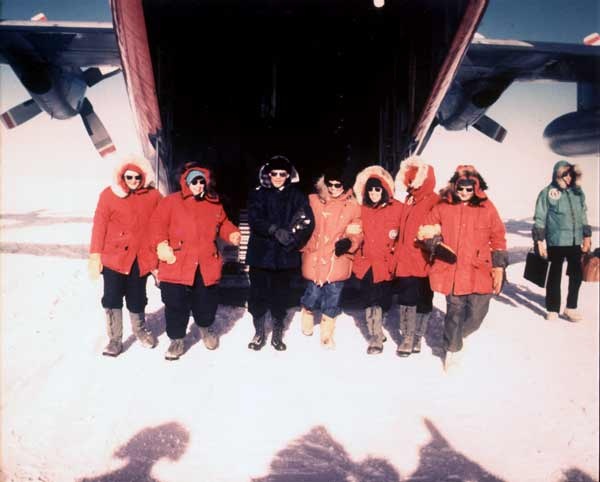
A photograph of the first women to set foot at the South Pole in November 1969. New Zealander Pamela Young is fourth from the left, dressed in a paler orange jacket than the other women.
What about our women? – first NZ women to visit Antarctica
The first New Zealand woman to visit the Antarctic mainland was zoologist Marie Darby in January 1968. She visited Scott Base with other staff and tourists after arriving on board the first tourist vessel to the Ross Sea area, the Magga Dan. In 2004 the New Zealand Geographic Board named a mountain after Darby.
The first New Zealand woman to work in Antarctica was Pamela Young in the summer of 1969-70 (New Zealander G.L. Hammond was the first woman to work in the sub-Antarctic in the summer of 1945-46). Young worked as part of the New Zealand Antarctic programme, as a field assistant to her biologist husband, Euan, at Cape Bird.
Young was also one of a party of six who became the first women to set foot at the South Pole in November 1969. Transported to the Pole by plane, they walked down the ramp together and stepped simultaneously onto the ice. After numerous photo opportunities, a guided tour of the South Pole station and lunch, they boarded the plane and left. In her book, Penguin Summer, Young reflected on this experience:
I simply couldn't think of the spot as that solemn goal to which Scott and Amundsen had toiled. Indeed, it seemed just the sort of Pole that Pooh and Piglet might have set out to find and it fitted perfectly into the circus like atmosphere of our own visit.
Despite its staged nature, their visit marked a shift in policy in the Antarctic. Until 1969 the United States Navy refused to transport women onto the continent, and the National Science Foundation (NSF), which coordinated most US scientific research in Antarctica, wouldn't allow women to work there. The Navy lifted its ban in 1969, and the NSF began inviting women to submit research proposals. Just as Young was the first woman included in the New Zealand Antarctic Programme, four of the five women who accompanied her to the Pole were the first women included in the US Antarctic Program.
In 2003 the New Zealand Geographic Board named a group of peaks after Young. The Young Peaks are 5 km long, with summits rising above 1200 m; they run west to east, starting 5 km east of Mount Coley, Churchill Mountains.
More New Zealand women visited in the years that followed. In 1979 Thelma Rogers of the Department of Scientific and Industrial Research (DSIR) became the first woman to winter over in Antarctica.
Further information
Books
- David L. Harrowfield, Call of the Ice: Fifty years of New Zealand in Antarctica, David Bateman Ltd, Auckland, 2007
- Pamela Young, Penguin Summer - or a rare bird in Antarctica, A H & A W Reed, Wellington, 1971
Links
- First women at Pole (southpolestation.com)

Community contributions